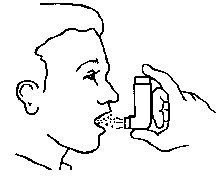| A. Hold inhaler 1 to 2 inches from your mouth (about the width of two fingers) | B. Use a spacer/holding chamber. These come in many shapes and can be useful to any patient. | C. Put the inhaler in your mouth. Do not use for steroids. |
 |
 |
 |
| Getting Ready | 1. Take off the cap and shake the inhaler.
2. Breathe out all the way. 3. Hold your inhaler the way your doctor said (A, B, or C below). |
| Breathe in Slowly | 4. As you start breathing in slowly through your mouth, press
down on the inhaler one time (if you use a holding chamber, first press
down on the inhaler. Within 5 seconds, begin to breathe in slowly.)
5. Keep breathing in slowly, as deeply as you can. |
| Hold your breath | 6. Hold you breath as you count to 10 slowly, if you can.
7. For inhaled quick-relief medication (beta2-agonists), wait about one minute between puffs. There is no need to wait between puffs for other medicines. |
| A. Hold inhaler 1 to 2 inches from your mouth (about the width of two fingers) | B. Use a spacer/holding chamber. These come in many shapes and can be useful to any patient. | C. Put the inhaler in your mouth. Do not use for steroids. |
 |
 |
 |
For quick-relief medications that you take as needed, count the number
of puffs you have used. Do not put the canister in water to see if
it is empty -- this doesn't work.